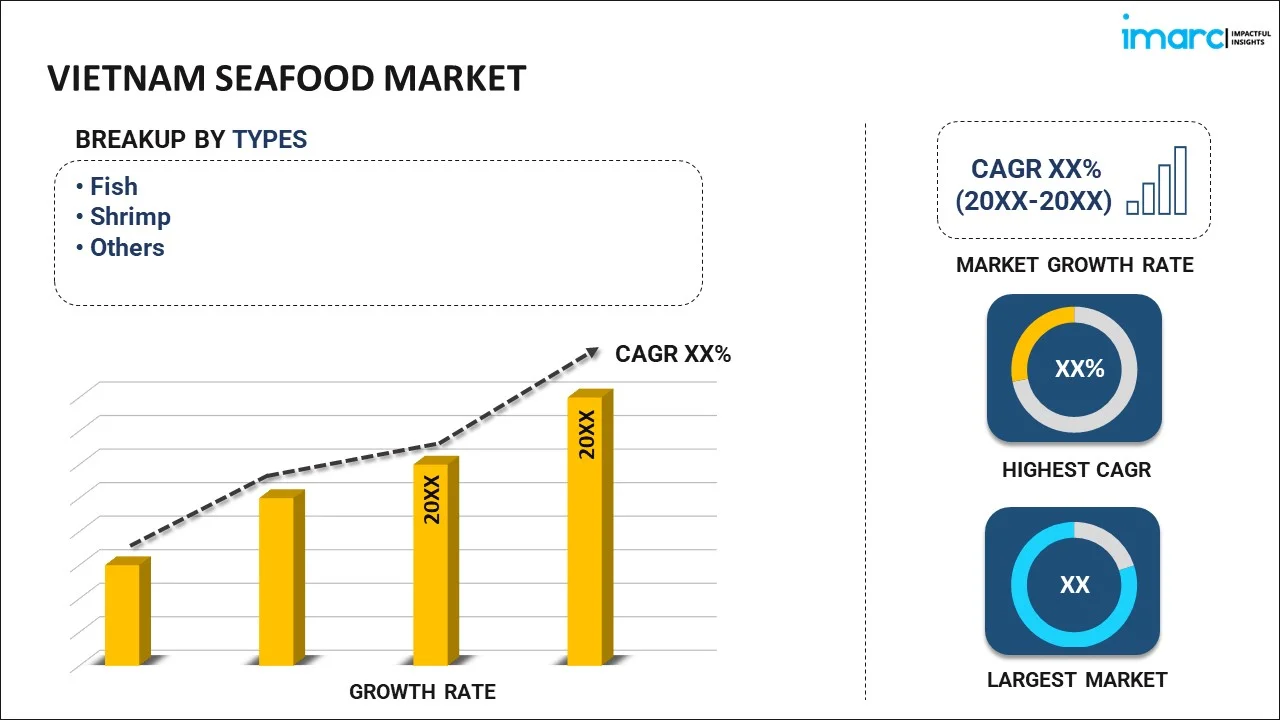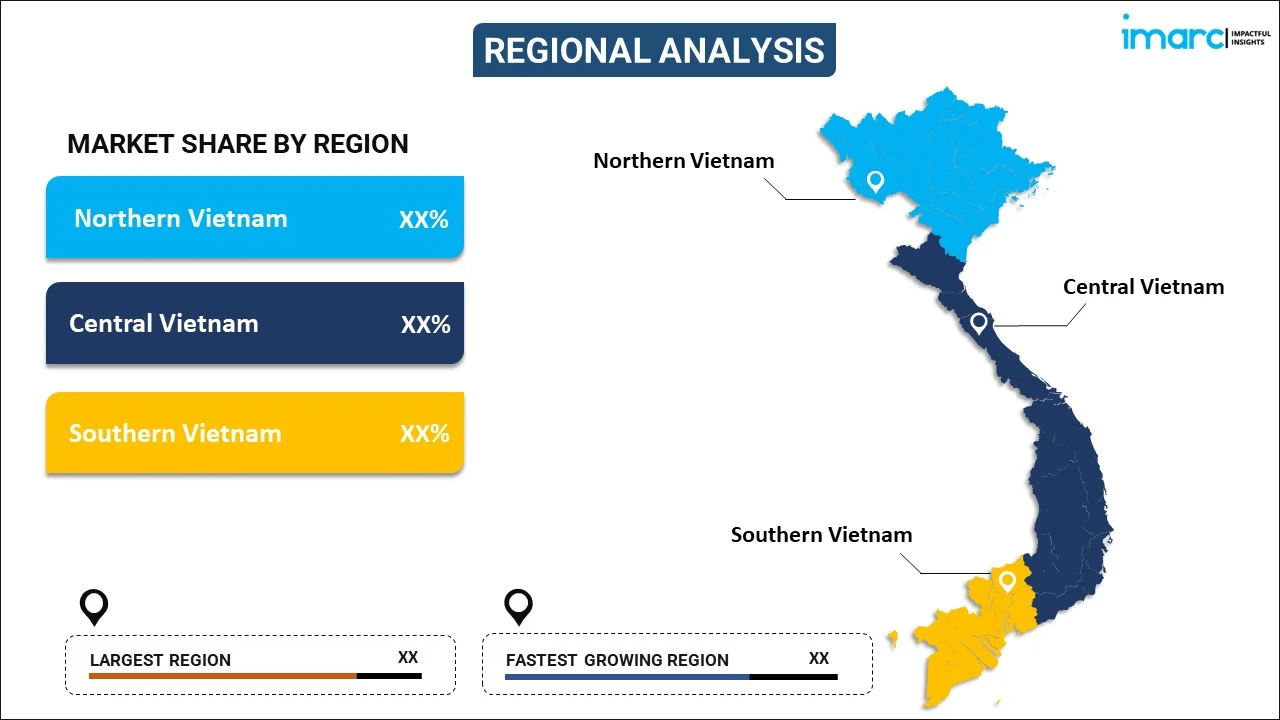
Vietnam Seafood Market Report by Type (Fish, Shrimp, and Others), Form (Fresh / Chilled, Frozen / Canned, Processed), Distribution Channel (Off-Trade, On-Trade), and Region 2025-2033
Market Overview:
Vietnam seafood market size reached USD 1,480.9 Million in 2024. Looking forward, IMARC Group expects the market to reach USD 1,874.0 Million by 2033, exhibiting a growth rate (CAGR) of 2.65% during 2025-2033. The seafood market in Vietnam is booming because of rich natural resources, inexpensive skilled workers, and increasing export demand. Expansion is driven by increasing e-commerce and technical progress, increasing competitiveness, and boosting sustainable development. The Vietnam Association of Seafood Exporters and Producers (VASEP) indicated that seafood exports totaled USD 10 Billion in 2024 and that more growth in 2025 would be expected as the industry continues to grow.
|
Report Attribute
|
Key Statistics
|
|---|---|
|
Base Year
|
2024
|
|
Forecast Years
|
2025-2033
|
|
Historical Years
|
2019-2024
|
|
Market Size in 2024
|
USD 1,480.9 Million |
|
Market Forecast in 2033
|
USD 1,874.0 Million |
| Market Growth Rate 2025-2033 | 2.65% |
Seafood refers to a broad category of aquatic organisms that are harvested for human consumption. It encompasses numerous marine and freshwater animals, including fish, shellfish, and crustaceans. Seafood is renowned for its nutritional value, offering an abundant source of essential nutrients such as protein, omega-3 fatty acids, vitamins, and minerals. Fish, a prominent seafood component, includes species like salmon, tuna, and cod, which are known for their unique flavors and culinary versatility. Shellfish, which include mollusks such as clams, mussels, and oysters, as well as crustaceans like shrimp, lobster, and crab, provide a delectable variety of textures and flavors that cater to diverse palates. Beyond its culinary appeal, seafood plays a vital role in many economies, supporting the livelihoods of millions of people worldwide. It is a cornerstone of global trade and commerce, with numerous countries relying on the export and import of seafood products. Additionally, the sustainable harvesting and management of seafood resources have become increasingly essential in ensuring the long-term health of oceans and aquatic ecosystems.
Vietnam Seafood Market Trends:
Rising Global Demand for High-Quality Seafood
Vietnam's seafood sector remains vibrant through robust export demand from major global markets. Favorable prices and stable product quality have established the country as a global seafood trade leader. Countries such as the US, Japan, and the EU are principal consumers, attracted to the variety of Vietnam's seafood. The integration of good supply chains and quality products positions Vietnam in a position to satisfy the changing demands of these markets, enhancing the reputation of the country as a reliable seafood supplier. With the world shifting its preference towards sustainably produced seafood, Vietnam's capacity to provide good-quality products at affordable prices ensures that it remains a prominent player in the Vietnam fish market.
Role of Free Trade Agreements in Expanding Market Access
Vietnam's seafood export business has greatly profited from free trade agreements (FTAs) with major global economies. These agreements have created new markets, cut tariffs, and strengthened Vietnamese seafood's competitiveness in global commerce. The EU-Vietnam FTA, in particular, has played an important role in facilitating access to European markets. These agreements also encourage greater cooperation, resulting in smoother commerce and increased sector growth. Vietnam's seafood industry is well-positioned for sustainable expansion, thanks to the widening reach of free trade agreements, which reduce regulations and enable larger export prospects, as seen in the Vietnam seafood export 2024 statistics.
Innovative Aquaculture Techniques Boosting Production Efficiency
Advances in aquaculture technology are transforming Vietnam's seafood industry. New advances, including as more effective breeding, feed optimization, and water management systems, are increasing the quality and quantity of seafood. These technical advancements minimize environmental impact and increase sustainability, making Vietnam's seafood business more competitive in a fast-changing market. Practices like integrated multi-trophic aquaculture (IMTA) and recirculating aquaculture systems (RAS) are gaining popularity, enabling more sustainable and scalable output. With these developments, Vietnam is expanding its output while maintaining ecologically friendly procedures, benefiting the overall Vietnamese seafood market.
Government Support and Growing Domestic Consumption
The Vietnamese government plays a crucial role in the growth of the seafood sector through targeted policies and incentives. Investments in infrastructure, marketing, and export support have strengthened the industry’s position both domestically and internationally. At the same time, domestic consumption of seafood has risen, driven by a growing middle class and changing consumer habits. This combination of government backing and a rising local appetite for seafood further fuels growth in the market, particularly in the Vietnam lobster market. With continuous government initiatives to promote sustainable practices and improve the competitiveness of the industry, Vietnam’s seafood sector is poised for long-term prosperity.
Vietnam Seafood Market Segmentation:
IMARC Group provides an analysis of the key trends in each segment of the market, along with forecasts at the country level for 2025-2033. Our report has categorized the market based on type, form, and distribution channel.
Type Insights:

To get more information on this market, Request Sample
- Fish
- Shrimp
- Others
A detailed breakup and analysis of the market based on the type have also been provided in the report. This includes fish, shrimp, and others.
Form Insights:
- Fresh / Chilled
- Frozen / Canned
- Processed
The report has provided a detailed breakup and analysis of the market based on the form. This includes fresh / chilled, frozen / canned, and processed.
Distribution Channel Insights:
- Off-Trade
- Convenience Stores
- Online Channel
- Supermarkets and Hypermarkets
- Others
- On-Trade
A detailed breakup and analysis of the market based on the distribution channel have also been provided in the report. This includes off-trade (convenience stores, online channel, supermarkets and hypermarkets, and others), and on-trade.
Regional Insights:

- Northern Vietnam
- Central Vietnam
- Southern Vietnam
The report has also provided a comprehensive analysis of all the major regional markets, which include Northern Vietnam, Central Vietnam, and Southern Vietnam.
Competitive Landscape:
The market research report has also provided a comprehensive analysis of the competitive landscape in the market. Competitive analysis such as market structure, key player positioning, top winning strategies, competitive dashboard, and company evaluation quadrant has been covered in the report. Also, detailed profiles of all major companies have been provided.
Vietnam Seafood Market News:
- In July 2025, VASEP urged the Vietnamese government to support the expansion of high-tech shrimp farming in the country. Companies like Grobest, CPF, and Skretting have introduced advanced farming models, while Minh Phu Seafood has developed MPBio, a farming system based on over 50 global shrimp-farming technologies. The move aims to enhance Vietnam's shrimp farming capabilities and competitiveness in the global market.
- In June 2025, Pakistan and Vietnam agreed to boost cooperation in the Halal seafood sector. The deal was finalized during a meeting in Karachi between Vietnam's Ambassador to Pakistan and Pakistan Fisheries Exporters Association members. The Marine Fisheries Department noted that Pakistan’s seafood exports to Vietnam hit USD 9 Million in 2024, marking a 20% increase from the previous year.
Vietnam Seafood Market Report Coverage:
| Report Features | Details |
|---|---|
| Base Year of the Analysis | 2024 |
| Historical Period | 2019-2024 |
| Forecast Period | 2025-2033 |
| Units | Million USD |
| Scope of the Report | Exploration of Historical Trends and Market Outlook, Industry Catalysts and Challenges, Segment-Wise Historical and Future Market Assessment:
|
| Types Covered | Fish, Shrimp, Others |
| Forms Covered | Fresh / Chilled, Frozen / Canned, Processed |
| Distribution Channels Covered |
|
| Regions Covered | Northern Vietnam, Central Vietnam, Southern Vietnam |
| Customization Scope | 10% Free Customization |
| Post-Sale Analyst Support | 10-12 Weeks |
| Delivery Format | PDF and Excel through Email (We can also provide the editable version of the report in PPT/Word format on special request) |
Key Benefits for Stakeholders:
- IMARC’s industry report offers a comprehensive quantitative analysis of various market segments, historical and current market trends, market forecasts, and dynamics of the Vietnam seafood market from 2019-2033.
- The research report provides the latest information on the market drivers, challenges, and opportunities in the Vietnam seafood market.
- Porter's five forces analysis assist stakeholders in assessing the impact of new entrants, competitive rivalry, supplier power, buyer power, and the threat of substitution. It helps stakeholders to analyze the level of competition within the Vietnam seafood industry and its attractiveness.
- Competitive landscape allows stakeholders to understand their competitive environment and provides an insight into the current positions of key players in the market.
Key Questions Answered in This Report
The seafood market in Vietnam was valued at USD 1,480.9 Million in 2024.
The Vietnam seafood market is projected to exhibit a CAGR of 2.65% during 2025-2033, reaching a value of USD 1,874.0 Million by 2033.
The seafood market in Vietnam is expanding due to rising global demand, particularly for shrimp and pangasius. The country's favorable climate and extensive coastline support robust aquaculture, while government incentives and technological advancements enhance production efficiency. These factors collectively bolster Vietnam's position as a leading seafood exporter.
Need more help?
- Speak to our experienced analysts for insights on the current market scenarios.
- Include additional segments and countries to customize the report as per your requirement.
- Gain an unparalleled competitive advantage in your domain by understanding how to utilize the report and positively impacting your operations and revenue.
- For further assistance, please connect with our analysts.
 Request Customization
Request Customization
 Speak to an Analyst
Speak to an Analyst
 Request Brochure
Request Brochure
 Inquire Before Buying
Inquire Before Buying




.webp)




.webp)












